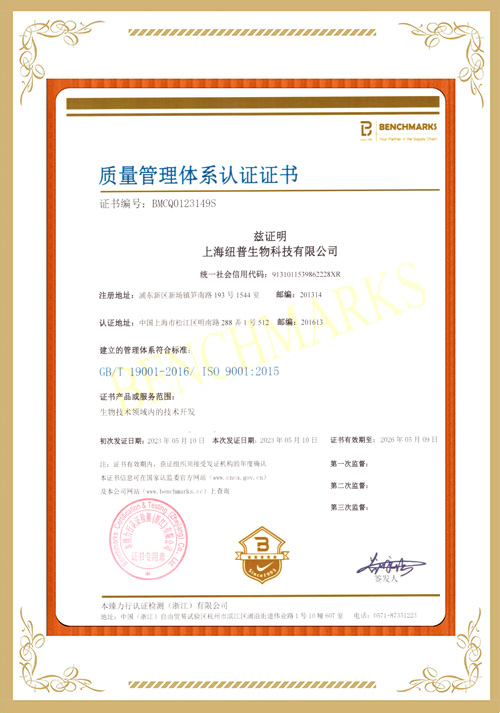重组H3N2 NA蛋白
- 蛋白种属:H3N2
- 表达宿主:人胚胎肾细胞(HEK293)
- Unitprot ID:C0LU95
产品详情
-
产品名称
重组H3N2 NA蛋白
-
蛋白种属
H3N2
-
表达宿主
人胚胎肾细胞(HEK293)
-
Unitprot ID
-
蛋白序列
His 36 - Pro 459
-
克隆构建
A DNA sequence encoding the Influenza A virus (A/Babol/36/2005 (H3N2)) neuraminidase (ACN50232.1) (His 36-Pro 459) was expressed, the cell lysates are collected, and bio-activity was tested.
-
蛋白活性
Measured by its ability to cleave a fluorogenic substrate, 2'-(4-Methylumbelliferyl)-α-D-N-acetylneuraminic acid.
The specific activity is > 800 U
One unit is defined as the amount of enzyme required to cleave 1 nmole of 2'-(4-Methylumbelliferyl)-α-D-N-acetylneuraminic acid per minute at pH 7.5 at 37℃.
-
分子量
The influenza H3N2 virus Neuraminidase comprises 443 amino acids.
-
蛋白全名
Neuraminidase
-
蛋白描述
Neuraminidases are enzymes that cleave sialic acid groups from glycoproteins. Influenza neuraminidase is a type of neuraminidase found on the surface of influenza viruses that enables the virus to be released from the host cell. Influenza neuraminidase is composed of four identical subunits arranged in a square. It is normally attached to the virus surface through a long protein stalk. The active sites are in a deep depression on the upper surface. They bind to polysaccharide chains and clip off the sugars at the end. The surface of neuraminidase is decorated with several polysaccharide chains that are similar to the polysaccharide chains that decorate our own cell surface proteins. Neuraminidase (NA) and hemagglutinin (HA) are major membrane glycoproteins found on the surface of influenza virus. Hemagglutinin binds to the sialic acid-containing receptors on the surface of host cells during initial infection and at the end of an infectious cycle. Neuraminidase, on the other hand, cleaves the HA-sialic acid bondage from the newly formed virions and the host cell receptors during budding. Neuraminidase thus is described as a receptor-destroying enzyme which facilitates virus release and efficient spread of the progeny virus from cell to cell. Influenza antibody and influenza antibodies are very important research tools for influenza diagnosis, influenza vaccine development, and anti-influenza virus therapy development. Monoclonal or polyclonal antibody can be raised with protein based antigen or peptide based antigen. Antibody raised with protein based antigen could have better specificity and/or binding affinity than antibody raised with peptide based antigen, but cost associated with the recombinant protein antigen is usually higher. Anti influenza virus hemagglutinin (HA) monoclonal antibody or polyclonal antibody can be used for ELISA assay, western blotting detection, Immunohistochemistry (IHC), flow cytometry, neutralization assay, hemagglutinin inhibition assay, and early diagnosis of influenza viral infection. NovoPro has developed state-of-the-art monoclonal antibody development technology platforms: mouse monoclonal antibody and rabbit monoclonal antibody. Our rabbit monoclonal antibody platform is one of a kind and offers some unique advantages over mouse monoclonal antibodies, such as high affinity, low cross-reactivity with rabbit polyclonal antibodies.
-
发货形式
Lyophilized from sterile PBS, 0.6% Triton X-100, 7% Trehalose, 6% Mannitol, pH 7.4
1. 5 % trehalose and mannitol are added as protectants before lyophilization.
2. Please contact us for any concerns or special requirements.
-
内毒素
< 1.0 EU per μg of the protein as determined by the LAL method
-
保存条件
Store it under sterile conditions at -20℃ to -80℃. It is recommended that the protein be aliquoted for optimal storage. Avoid repeated freeze-thaw cycles.
重组蛋白定制服务:
纽普生物(NovoPro)提供大肠杆菌、哺乳细胞、昆虫细胞和酵母细胞重组蛋白定制服务
声明:本公司出售产品只能用于科研目的,不得用于诊断或者治疗!


